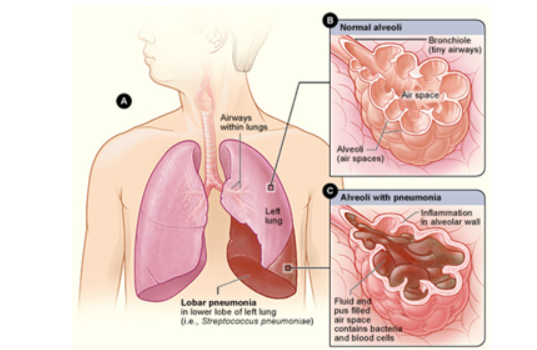Oleh: Thalia Kaylyn Averil
Pneumonia is an infection that occurs in the lungs resulting in a buildup of fluid or pus in the alveoli, namely the air sacs in the lungs. This infection can affect one or both lungs. Pneumonia can be caused by viruses, bacteria, fungi or parasites. For pneumonia caused by viruses, the most common viruses are influenza virus, respiratory syncytial virus (RSV), and severe acute respiratory syndrome coronavirus 2 (SARS-CoV-2). Pneumonia caused by bacteria can be further classified into two, namely typical and atypical bacteria. Typical bacteria can be cultured on standard media, while atypical bacteria cannot be cultured on standard media. Typical pneumonia is characterized by infections caused by Streptococcus pneumoniae, Haemophilus influenzae, Staphylococcus aureus, or Moraxella catarrhalis. On the other hand, atypical pneumonia is mostly caused by Legionella, Mycoplasma pneumoniae, Chlamydia pneumoniae, and Chlamydia psittaci. Pneumonia can affect people of all ages, but there are some individuals who are more susceptible to pneumonia, namely:
- Elderly aged over 65 years
- Children aged less than 5 years
- Smoking habits can damage the lungs and reduce the response of the immune system to infections
- Individuals with chronic heart disease or diabetes mellitus are more susceptible to pneumonia because it can weaken the immune system
- Weak respiratory organ structures can make the lungs more susceptible to infections
The lungs are not sterile organs. Bacterial species such as Streptococcus and Mycoplasma that are often associated with pneumonia are part of the normal lung microbiome. The immune system in the lungs will keep microbes under control. If the immune system is compromised, viruses, bacteria, fungi, or parasites that enter the lungs can proliferate and replace the normal microbiome, allowing the invading microorganisms to grow excessively and cause infection. When the immune system responds to an infection, it can cause acute inflammation resulting in an increase in inflammatory cells in the air sacs of the lungs.

Figure 1. Comparison of normal lungs and lungs that have been infected with pneumonia.
In the latest pneumonia classification, pneumonia is divided into four categories, namely community-acquired pneumonia (CAP), hospital-acquired pneumonia (HAP), healthcare-associated pneumonia (HCAP), and ventilator-associated pneumonia (VAP). The main cause of community-acquired pneumonia (CAP) is Streptococcus pneumoniae, followed by Klebsiella pneumoniae, Haemophilus influenzae, and Pseudomonas aeruginosa. This is different from the cause of the pneumonia outbreak currently occurring in China, namely Mycoplasma pneumoniae.
Symptoms of pneumonia can be mild or severe, depending on the cause, age, and overall body health. Pneumonia symptoms are also sometimes similar to flu symptoms. Pneumonia can cause symptoms that include:
- Chest pain when breathing or coughing
- Shivering
- Fever
- Cough with/without mucus
- Low blood oxygen levels
- Shortness of breath
Apart from that, other symptoms that pneumonia sufferers can experience are muscle pain, fatigue, nausea, vomiting, and diarrhea. Older individuals may experience confusion, fatigue, and a body temperature lower than normal, but not a fever. For infants, common symptoms include vomiting, restlessness, or showing signs of respiratory problems. If you experience the following symptoms, contact a doctor for further diagnosis and treatment!
Diagnosis of pneumonia is by examining the lungs, such as listening to abnormal sounds using a stethoscope when breathing. In addition, a chest x-ray can also be done to determine the location and cause of pneumonia. In connection with the previous one, blood and phlegm tests can also be carried out to determine the cause of the infection. Pulse examination is carried out to assess the amount of oxygen circulating in the body to determine the severity of pneumonia in affecting air exchange in the lungs.
So, what things can you do to prevent getting pneumonia? Check out the method below!
- Pneumonia is most effectively prevented by vaccination. Certain types of pneumonia can be prevented by receiving influenza and pneumococcal vaccines.
- Washing your hands frequently with soap and water can help stop the transmission of pneumonia-causing microbes.
- A balanced diet, frequent exercise, and quitting smoking are one way to improve the body’s immune system so that it can prevent pneumonia.
- Manage chronic conditions such as chronic heart disease, diabetes mellitus, or asthma
- Avoid direct contact with individuals suffering from pneumonia
Resources
- Sorongan TP. Fakta baru pneumonia anak misterius yang ‘meledak’ di China [Internet]. Jakarta: CNBC Indonesia; 2023 Des 1 [cited 2023 Des 3]. Available from: htt4ps://www.cnbcindonesia.com/news/20231201180353-4-493871/fakta-baru-pneumonia-anak-misterius-yang-meledak-di-china
- Rahmadania SR. Dokter paru: penyebab wabah pneumonia di China sudah lama ada di RI [Internet]. Jakarta: detikHealth; 2023 Des 1 [cited 2023 Des 3]. Available from: https://health.detik.com/berita-detikhealth/d-7066132/dokter-paru-penyebab-wabah-pneumonia-di-china-sudah-lama-ada-di-ri
- National Heart, Lung, and Blood Institute. What is pneumonia? [Internet]. Bethesda: National Heart, Lung, and Blood Institute; date of publication unknown [updated 2022 Mar 24] [cited 2023 Des 3]. Available from: https://www.nhlbi.nih.gov/health/pneumonia
- Center for Disease Control and Prevention. Pneumonia [Internet]. Atlanta: Center for Disease Control and Prevention; date of publication unknown [reviewed 2022 Sep 30] [cited 2023 Des 3]. Available from: https://www.cdc.gov/pneumonia/index.html
- Kementerian Kesehatan Republik Indonesia. Pneumonia [Internet]. Jakarta: Kementerian Kesehatan Republik Indonesia; date of publication unknown [cited 2023 Oct 31]. Available from: https://ayosehat.kemkes.go.id/topik-penyakit/infeksi-pernapasan–tb/pneumonia
- Sattar SB, Sharm S. Bacterial pneumonia [Internet]. Unknown ed. Treasure Island: StatPearls Publishing; date of publication unknown [updated 2023 Aug 14] [cited 2023 Dec 9]. Available from: https://www.ncbi.nlm.nih.gov/books/NBK513321/
